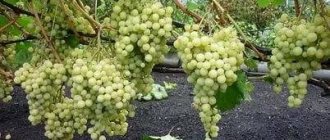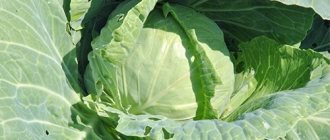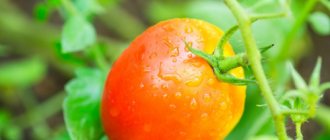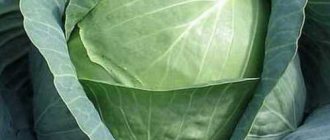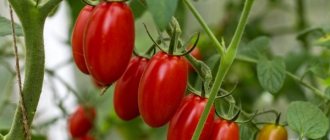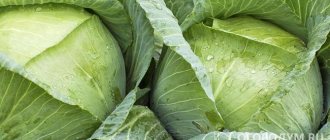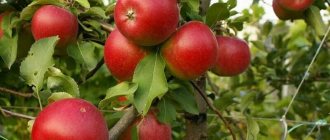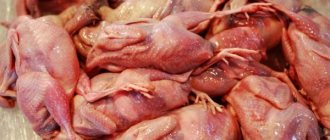Planting material retains good germination for 4 years.
Pink leader is a proven and favorite variety of many gardeners. By planting this unpretentious variety and following all the agricultural techniques for growing and caring, you can enjoy your first harvest of sweet pink tomatoes in just three months.
Brief information about the variety
- Fruits: weight up to 150 g, pink color.
- Bush: standard, determinate, height up to 50 cm.
- Productivity: 2-2.5 kg per bush.
- Resistance: high cold resistance is noted, and good immunity to late blight is also observed.
- Distribution: grown throughout Russia. In the southern and temperate regions, planting in open ground is allowed; in the northern side it is necessary to plant in a greenhouse.
- Application: fresh – in salads, in tomato juice; in the preparation of pastes, ketchups, sauces. Preservation is not recommended.
- Planting: use the seedling method. The procedure is carried out at the end of May according to the 50x40 cm pattern.
- Soil: fertile, light and turfy.
- Feeding: mineral complex fertilizers every 10 days
- Watering: regular, sufficient, during the flowering period of the first two clusters - plentiful.
- Stepsonning: optional.
- Formation: not required.
- Ripening period: from mid-July to the end of September
Description of the tomato variety Pink Leader
This variety has a fast ripening time. The tomato was bred by agro specialists. It can be grown both in greenhouses and in the garden. The pink leader is a determinant. The bush is standard, low-growing (maximum height 50 cm).
It has pubescent branches with large leaves of a rich green hue. When 5 to 7 permanent leaves are formed on the bush, the first ovary will appear. Up to 5 tomatoes ripen on one bunch at the same time. This happens 86-90 days after the first shoots appear. Due to the compact size of the bush, Pink Leader can also be grown on the balcony. It will be a wonderful decorative element.
general characteristics
An early ripening, low-growing, productive tomato variety for open ground and film shelters.
Suitable for growing without seedlings in areas of unsustainable agriculture. The period from germination to the beginning of ripening is 85-90 days. Bush of determinant type, standard, 40-50 cm high. Does not require pinching. The leaf is large and green. The inflorescence is simple.
The Pink Leader tomato is included in the State Register of the Russian Federation for cultivation in open ground and under film covers in private household plots.
The fruits are flat-round, dense, pink in color at maturity, weighing 120-150 grams, fleshy, good taste for early varieties.
Productivity of the Pink Leader variety: up to 8 kg of fruits per 1 sq. meters of landings.
Advantages of tomato: resistance to late blight and adverse weather conditions, friendly yield.
Tomato Leader is a determinate, low-growing variety. The bushes are thick and strong, moderately spreading and sparsely leafy. Shoots do not grow higher than 50-60 cm.
Ripening dates are early - 95-110 days from germination.
Characteristics of tomatoes:
- average weight 70-100 g;
- seed nests, few seeds;
- the pulp is fleshy, sugary;
- the skin is strong;
- The taste is dominated by sweetness.
Pink Leader tomatoes were bred agro. In 2008, it was included in the State Register and recommended for cultivation in open and protected ground throughout Russia.
The variety is ultra early ripening. From the first shoots to the receipt of fruits, only 2.5 months pass.
Description of the bush
The plant is low (45-50 cm), compact. Practically does not require pinching and shaping.
The bushes are small, so you can plant up to 7-8 pieces per 1 m² and get up to 16 kg of fruit in total.
The tomatoes set and ripen at the same time. And this is another advantage when harvesting. The foliage is dark green, oblong.
Description of fruits
Tomatoes Pink leader against the background of a small bush are quite large, about 150 g. Beautiful soft pink color, smooth, rounded.
The pulp is fleshy and dense, the taste is quite sweet, so children love the fruits, and they are also recommended for people with high acidity.
To increase the shelf life of the crop, it is advisable to wrap each specimen in paper and put it in the refrigerator, periodically changing newspapers to keep it dry.
Productivity
Among its determinate counterparts, this tomato is the most productive. In open ground you can collect up to 10 kg/m², and in protected ground – up to 15-16 kg.
Productivity is fully influenced by soil fertility. It should be light, breathable, rich in organic matter and minerals. The variety needs to be watered systematically, especially during the period of fruit ripening.
Application of fruits
The fruit has a sweet taste
Thanks to its taste, the tomato is loved by many. It has a sweet taste and minimal acidity. It is useful to eat it fresh in salads, in freshly squeezed juices, and goes well with other sliced vegetables.
According to the description, a tasty and rich taste is obtained when preparing tomato paste and ketchup.
But this variety is not entirely suitable for canning. During heat treatment, the thin skin bursts and the contents spill out. The appearance is not aesthetic, and the product deteriorates faster due to the damaged outer shell.
According to the description, the Pink Leader tomato has high immunity. Thanks to this property, it can combat weather changes and has high frost resistance.
The variety is resistant to a number of fungal diseases. And first of all – to late blight. But don't forget about prevention.
You can spray with Bordeaux mixture to prevent fungal diseases.
Or you can use folk remedies, for example, an infusion of garlic inflorescences (25-30 pcs per bucket of water, leave for 1-2 days and spray the tomatoes).
Growing regions
Pink Leader is an early ripening variety, so tomatoes are grown throughout Russia.
It is especially popular in the middle zone, the Urals, and Siberia. Summer in these regions is cold and short, so gardeners choose varieties with quick ripening.
This variety is a record holder among early ripening tomatoes. Fruiting lasts from early July to mid-September.
Tomato Pink leader "Sedek" is considered an ultra-early variety - 85-90 days pass from the appearance of the first shoots to the ripening of the fruits. It is listed in the State Register of the Russian Federation and is recommended for cultivation under film or in open ground.
The plant is standard, low-growing, determinate, that is, it stops growing upward when the fruits begin to develop on the clusters. Its height is 40-50 cm, the stems are powerful and strong. The leaves are dark green and large. Tomato stalks are articulated. The inflorescence belongs to the simple type.
The fruits are average, 120-150 grams each, sometimes reaching 170 grams. At maturity they are deep pink in color. They have a flat-round shape and may have slight ribbing. The pulp is dense, but not hard, fleshy and juicy. It contains a lot of sugar, the taste is sweet, the sourness is weak.
Tomatoes are distinguished by a significant content of lycopene, which can fight atherosclerosis, as well as vitamins C, PP and B.
Universal use - both for canning and pickling, and for preparing salads, various dishes and cuts, sauces, pastes. Tomatoes make very tasty juice.
History of the variety's creation
This variety is the fruit of selection by Russian specialists, included in the State Register for cultivation in garden beds and greenhouses on private farms. Due to its early ripening, Leader tomatoes can be grown in the middle zone or in Siberian conditions, where the summer is not too long and quite cool, but the fruits of this variety have time to ripen.
There is another variety of Leader - Red. It differs from Pink in the rich red color of the fruit. Often, when buying seeds, summer residents make the mistake of purchasing Leader tomato seeds; they believe that they are buying its pink variety. However, you need to look carefully at the packaging, which shows ripe fruits - red. Red Leader tomatoes are also quite popular among vegetable growers, as they are early varieties, resistant to temperature fluctuations, and ripe fruits have a good presentation and good taste.
Tomato Pink Leader
Advantages and disadvantages
Pros:
- high productivity;
- great taste;
- early ripening;
- resistance to a number of major diseases;
- resistance to climatic conditions;
- long shelf life and good transportability;
- high content of vitamins and substances valuable to the body.
Minuses:
- There are practically no disadvantages.
Advantages of the variety:
- early ripeness;
- amicable maturation;
- excellent germination;
- cold resistance.
Of the minuses:
Pros and cons of the Pink Leader tomato variety
The advantages of these tomatoes include:
- High yield.
- Strong immunity (Pink Leader bushes are resistant to bacterial and viral diseases).
- Different methods of cultivation (in the ground, greenhouse, seedlings and non-seedlings).
- Good shelf life and preservation of presentation after transportation.
- Resistance to various weather conditions.
- Nutritional value of fruits. They contain a huge amount of minerals and vitamins that protect the heart and blood vessels.
The Pink Leader tomato has practically no negative characteristics. The only thing that may confuse summer residents is the delicate skin and the not too large size of the fruit.
Agricultural technology
Numerous experiences of gardeners have shown that this tomato, due to its compactness, can be planted even in small areas. If there are no greenhouses, gardeners are limited to greenhouses or “warm” beds.
Warm beds begin to be made in early May.
Manure, radish tops or grass (one to choose from) are placed at the bottom of the bed. Dilute well with hot water. The top is covered with earth. Cover with film and leave to warm up. After 3-4 weeks everything is ready.
This is a good analogue of a greenhouse bed. Tomatoes ripen 2 weeks earlier.
Growing seedlings
Before you sow the seeds, you need to prepare the soil. Any nutritious soil that you can buy in a store will do. Or do it yourself by mixing peat and sand (1:1). Seeds are sown in late March - early April.
Sowing algorithm:
- treat the seeds with a weak solution of manganese;
- make shallow grooves - 1-1.5 cm;
- put seeds in them and spill them;
- lightly cover with soil;
- cover with polyethylene.
After about 5-7 days, the first shoots will appear. After this, the film is removed. The seedlings are placed in a sunny place. When permanent 2-3 leaves appear, the seedlings are pruned.
Transfer
Plants are easy to care for
So, when the seedlings have grown stronger and grown, they already have 5-6 leaves - it’s time to transplant them to a permanent place in open ground or a greenhouse.
After about 7 days, the seedlings begin to be taken out into fresh air for hardening. Depending on the region, at the beginning or end of May, plants are planted in a permanent place. Planting pattern 50 X 40 cm.
Algorithm:
- prepare the soil - remove weeds and dig up;
- make shallow holes, about half a shovel deep;
- put 10-15 g of nitrogen-phosphorus fertilizer, mix with soil;
- spill the holes with water;
- remove the seedlings from the container and place them in the holes;
- cover with soil, compacting it slightly;
- water again.
Sometimes it happens that when planting, part of the root is accidentally broken off. It's OK! Tomatoes regenerate roots quickly enough and the plant does not die.
Vegetable growing technology
Sowing seeds for seedlings should be carried out in March or April , depending on the region of growth.
Sowing seeds for seedlings
First you need to prepare a container for planting, soil and seeds. The container can be very different, but a good solution would be to use special containers with lids to create a greenhouse effect. Planting material can be bought at a specialized store or collected independently from the harvest.
Before sowing, the seeds should be heated and treated in a solution prepared on the basis of potassium permanganate, and also checked for germination.
Further care
According to its characteristics, the Pink Leader variety is quite unpretentious in care. But if you want to get a rich harvest, you need to follow some rules.
- Watering. Regular and moderate is required. Make sure that the water does not stagnate in the roots, but flows freely into the ground. Irregular watering can cause a decrease in yield.
- Loosening. It is advisable to provide more oxygen to the roots after each watering.
- Weeding. Regularly remove weeds, which grow faster than the crop and often cause weakening and even death of the plant.
- Thinning. Remove the lower leaves to allow more nutrients to reach the fruit.
- Feeding. Nourish the plant with organic and mineral substances.
- Prevention of diseases.
Taste qualities of Pink Leader tomatoes
According to reviews from the photo, the yield of the Pink Leader is quite large. Ripe fruits acquire a red tint with delicate pink tints. But unripe tomatoes are colored light green. The weight of one tomato reaches 150-170 g. They have a slightly rounded shape, with ribs appearing on the skin. The pulp is quite dense and juicy. Pink leader tomatoes are sweet, with barely noticeable sourness.
Tomatoes are consumed fresh, as an ingredient for salads, and also for making homemade juices, pastes and ketchups. The variety is not used for pickling. The thin skin quickly cracks, and the workpieces look unaesthetic.
Features of cultivation, planting and care
Seeds are sown at the end of February, beginning of March.
Planting depth is 2 cm. Until germination, the boxes are kept, as in a greenhouse, under a film.
To get strong seedlings:
- feed 2 times with Kemira-Lux;
- irrigate with warm water;
- dive into 0.3 liter pots.
Ultra-early / Low-growing
User rating: 4/5
Early maturing / Low growing
User rating: 4/5
Early maturing / Low growing
The variety can be planted in ordinary open-air gardens, in film shelters, as well as in vertical beds. It bears fruit well in pots, in balcony boxes, in multi-tiered beds, which are used simultaneously for decoration and harvesting. However, when grown in small boxes, the bushes need more frequent watering.
The plant does not require pinching and can do without tying it to a support.
The collected fruits are stored well and tolerate transportation well, but they must be handled with care so as not to damage the thin skin.
Sowing the seeds of this variety of tomatoes for seedlings is carried out 55-60 days before the intended planting in the ground. Seedlings dive at the stage of 2 true leaves. When planting seedlings in a permanent place per 1 sq. m it is recommended to place up to 6 plants.
Further care of the plantings consists of weeding, timely watering, fertilizing with complex mineral fertilizer, as well as preventive measures to protect the crop from diseases and pests.
If you grew early-ripening Pink Leader tomatoes, please write in the comments whether you liked them or not. What was the yield and taste of the fruits in your climatic conditions? Will you grow them again? How do you rate the disease resistance of this variety? If possible, attach a photo of the entire bush or individual fruits you grew. Thank you!
Your reviews of the Pink Leader tomato and additions to the description will help many gardeners evaluate this variety more objectively and decide whether it is worth planting or not.
This is a natural variety of tomato. Therefore, we recommend taking seeds from a ripe fruit and growing them again next season!
Basic care measures
The Pink Leader does not require special care. To get a rich harvest, all you need is:
- control the level of humidity throughout the entire crop growing cycle, since drying out threatens fruit shrinkage, crop loss and plant death;
- loosen the soil after each watering, this will enrich the soil with oxygen and prevent the formation of a dry crust on the surface of the earth;
- weed as necessary , removing weeds;
- form bushes , leaving 1-2 well-developed strong stems;
- feed with mineral complexes or special fertilizers for tomatoes;
- gradually remove the lower leaves , which cause air stagnation in the ground zone, which leads to the appearance of plant diseases;
- carry out preventive measures aimed at preventing infection of vegetable crops with diseases and pest invasions.
Proper implementation of the entire range of care work will allow you to avoid diseases and enjoy delicious, aromatic fruits.
Errors during cultivation
All season you tried, looked after the tomatoes. But the result was not at all what was expected. Let's look at what mistakes might have been made.
- Early sowing. Some gardeners think that the sooner they plant, the sooner they will get a harvest. But it turns out the other way around. Seedlings are stretched due to lack of light. It becomes thin and painful. And, as a result, low adaptation to a permanent planting site and a late harvest.
- Stimulating sweetness in the taste. If you add salt to the water when watering, the sweetness of the fruit will increase. But this cannot be done. As a result, you will ruin the soil and plants. Sweetness depends more on the variety.
- Thickening of plantings. Air ventilation at the root part of the plant is disrupted, which leads to their disease.
- Don't overfeed. In this case, the plant begins to “fatten”, grows rapidly and forgets about bearing fruit.
- Incorrect watering. Tomatoes do not like excess moisture. As a result, you may end up with root rot or other diseases.
What not to do
Sometimes there are recommendations online on how to get sweeter tomatoes. Among these recommendations is the addition of table salt to irrigation water. Under no circumstances should you do this, you will ruin the soil and seriously harm the plants! The accumulation of sugars in tomatoes depends on the genetic characteristics of the variety, as well as the provision of heat, light and potassium.
Try growing this variety and see that it is a leader!
Planting and care
Tomatoes must be planted in light, loose and nutritious soil. You can buy it in a store or prepare it at home from peat and sand in equal parts. Garden soil and wood ash are often added to this composition.
Before sowing, seeds are disinfected in a weak solution of potassium permanganate and slightly warmed. Before doing this, you need to select quality ones - pour the seeds from the bag into water in which 5% salt is dissolved. Those that float are unusable.
The grains are buried no more than 1-1.5 cm, then carefully, so as not to wash them off, they are watered and the boxes are covered with film or glass. After 5-7 days, shoots should appear in a warm place.
When the seedlings develop 2 leaves, they are picked.
Two weeks before planting in open ground, the bushes begin to harden off. They are watered a little less, and also taken out into the air every day and left there first for half an hour, then increase the period.
For tomatoes, a well-lit sunny area, protected from strong winds, is suitable. It is best if zucchini, cucumbers, dill, parsley, onions or cabbage grew on it before.
In the fall, the site is dug up and fertilizers are applied. In the spring, tomatoes are re-fertilized and planted according to a 50 by 40 cm pattern. You can plant up to 8 bushes per 1 square meter. m.
They are regularly watered and the soil is loosened. To increase productivity, it is worth forming bushes with 1-2 stems.
Ultra-early / Low-growing
User rating: 5/5
Early maturing / Low growing
User rating: 4/5
Disease and pest control
The Pink Leader variety has good immunity, so it is slightly susceptible to diseases. But, nevertheless, in order to avoid disease and not lose the plant, it is necessary to carry out disease prevention, which includes the following measures:
- Seeds. Select only healthy, high-quality seed material.
- Landing. If you are planting in open ground, then try to plant further from potatoes, since they have various pests and diseases in common with tomatoes.
- Detect the disease in a timely manner. If the bush cannot be saved, it is better to destroy it (burn it).
Optimal growing conditions
Pink leader can be grown in a variety of conditions. Tomatoes of this variety delight with excellent taste and high yield in greenhouses. They are also actively grown in vertical beds. The pink leader will be a godsend for owners of small plots. Due to their compact root system, bushes are often grown in tubs and multi-tiered beds.
Attention! Pink cape grows well in Siberia and the Urals. Summer here is cool and short, so gardeners prefer to plant early-ripening tomatoes.
Method of obtaining seeds
As practice has shown, recently many purchased seeds turn out to be of low quality and have poor germination. Gardeners collect seeds from their own harvest and their results are much better.
But quality also depends on doing the right thing.
- To collect seeds, only ripe and large fruits are selected.
- Wash the tomato well, cut it, collect the seeds with a spoon, and place in a glass bowl.
- The seeds should ferment within 1 day at a temperature of 25°.
- Next, place the seeds on cheesecloth and rinse, removing mucus.
- Dissolve a teaspoon of salt in a glass and put seeds into the solution: good ones will sink to the bottom, and bad ones will float to the surface.
- Dry good seeds for a week at a temperature of 25° on a saucer.
The resulting seeds can be stored in a paper bag in a cool, dark place for 3-4 years.


